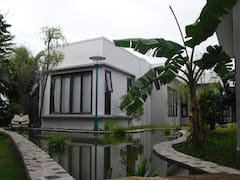When you think about typical Vietnamese cuisine, the first thing that comes to mind is often “pho”. What most foreigners are unaware of is that apart from pho, there are so many gorgeously delicious Vietnamese foods found in different cities of Vietnam. Depending on the region, there are many variations of the same dish, and each comes with a unique smell, flavor, and texture, as well as varied ingredients.
If you haven’t experimented with Vietnamese cuisine yet, let the below list be the initial guide on your culinary journey. There is more to Vietnam than just noodles and soup!!
SOUPS

Vietnamese soups are known to be both wholesome as well as flavorsome and come with generous amounts of veggies and seafood.
Bún bò Huế (beef vermicelli soup)

Bún bò Huế, or bun bo, is a Vietnamese soup containing beef (bò) and originating from Hue, a former royal capital city. Lemon grass is the predominant flavor, and it has a fine balance of spicy, sour, salty, and sweet notes. As compared to phở or bún riêu, the noodles are much thicker and more cylindrical.
It is served with diced green onions, lime wedges, raw sliced onions, cilantro sprigs, chili sauce, red cabbage, thinly sliced banana blossom, mint, basil, and sometimes bean sprouts.
Bún riêu (crab and tomato noodle soup)

Bún riêu is a Vietnamese meat rice vermicelli soup served with thin rice noodles and stewed tomato broth and topped with crab or shrimp paste. There are several varieties of bún riêu and in some northern parts, tamarind powder is used to get a characteristic sour taste of the soup. Traditionally the soup was made with whole blue crabs pounded with a large mortar and pestle and then separating the crab meat from the crushed body.
You might be interested in these Airbnbs!
Hủ tiếu (rice noodle soup)

Hu tiếu is a noodle soup made with a pork bone broth and a variety of noodles, but no fish sauce. The noodles can be clear tapioca noodles, thin Chinese egg noodles, or white rice noodles. The toppings too can be varied, including squid, shrimp, pork ribs, boneless pork, wonton dumplings, fried garlic, and fried shallots.
It is one of those dishes you can pick and choose whatever you want and it is a good choice for someone trying out Vietnamese cuisine for the first time.
Bánh canh bột lọc (thick noodle soup)

Bánh canh is a thick Vietnamese noodle made from tapioca flour and bánh canh bột lọc is a more translucent and chewy version of the same noodle and looks like white pasta. It comes in various versions depending on which region you are in. The soup broth can vary between pork, crab, fish, and the toppings can be ham, fish cake, shrimp balls, mushrooms, and others.
Canh chua (Vietnamese sour tamarind soup)

Canh chua is a dish from the Mekong Delta and is made with fish, seafood and vegetables found in this region. The other ingredients that are added include pineapple, okra, bean sprouts, tomatoes, tamarind, and a variety of herbs, such as lemony ngo om, The sour taste of the soup comes from the tamarind.
A traditional Vietnamese meal of canh chua is served either with steamed jasmine rice or with rice vermicelli noodles.
The soup’s contrasting flavors of sweet, savory, and sour, along with the contrasting textures of all the different vegetables is what sets it apart from other soups.
Cháo (congee / porridge)

Congee is a type of rice porridge or a kind of rice soup popular in many Asian countries. It is primarily a comfort food or a food to help get through the colds and illnesses!
It is served with side dishes when eaten as plain rice congee, but if ingredients such as meat, fish, etc, are added while preparing the congee, it is served as a one-pot meal.
Each Asian country has its own variation, but essentially it is a thick porridge of rice made by cooking small grains of rice in a savory soupy broth until they are soft and tender.
The Vietnamese version of congee is eaten with fried Chinese doughnuts (quẩy), for that extra dose of carbohydrates!
SNACKS
Vietnamese cuisine consists of lots of food that, though usually served with full-on meals, makes for some great foods to snack on in between meals.
Bánh cuốn (steamed rice cake)

Bánh cuốn literally means “Rolled cake”. It is a light and flavorful dish from Northern Vietnam. Bánh cuốn is a light crepe, often with ground pork, minced mushrooms, and onions, and eaten along with Vietnamese ham (cha lua), steamed bean sprouts, and cucumber as accompaniments. Another version of bánh cuốn is known as thanh tri, where, instead of being rolled, the crepe is kept in sheets without any filling, and sprinkled with fried onions.
Gỏi cuốn (spring rolls)

This is a Vietnamese spring roll, which traditionally consists of rice vermicelli, prawn, pork, and fresh vegetables wrapped in Vietnamese bánh tráng (rice paper) along with a few other ingredients. These are not cooked on the outside or deep fried, rather they are served at room temperature.
Gỏi cuốn is a a very popular appetizer in Vietnamese restaurants and, in 2011, it was listed at number 30 of the World’s 50 Most Delicious Foods as complied by CNN Go.
Bánh xèo (sizzling pancake)

The Vietnamese word xeo embodies the sizzling sound made when the batter for these pancakes hits the pan. Bánh xèo therefore literally means the “sizzling cake”.
It is a savory fried pancake or crepe made of rice flour, water, and turmeric powder and it is stuffed with slivers of pork or chicken, shrimp, bean sprouts and diced green onion.
The ingredients and preparation, and even names, vary across the stretch of the country. The southern-style pancakes are served wrapped in mustard leaves and lettuce leaves. They contain coconut milk, are more generously stuffed with the filling, and they are served with a sweet and sour diluted fish sauce dip.
In the Central Region, the bánh xèo is wrapped in fresh rice paper with a sausage and then dipped in a special sauce of fermented soybean and ground pork liver. It is then topped with ground and toasted peanut.
Bánh khọt (miniature fried pancakes)

Mini-sized rice cakes served with vegetables, fresh mustard leaves, herbs, and a spicy sweet fish sauce for dipping, bánh khọt is a famous Vietnamese dish.
These fried cakes are made of rice flour and coconut milk batter and are savory in taste. They are made in a unique cupcake-like pan. They are popular as street food in Vietnam.
Cơm tấm (broken rice)

Cơm tấm means “broken rice”. Traditionally, the grains of rice that were broken during the process of harvesting and transporting were used as animal feed or eaten just by poorer members of society. Nowadays, however, it is one of the most-loved dishes in Vietnam.
Cơm tấm is served with grilled pork and shredded pork with pork skin (known in Vietnamese as bì) over broken rice, accompanied by pickled vegetables, various greens, a prawn paste cake, steamed egg, and even grilled prawns.
DESSERTS
In Vietnam, meals are generally finished off with a plate of fresh fruit, but there are certain popular desserts for those who need to indulge their sweet tooth.
Lychee and lotus fruit consomme
Editor's Note: There's no photo available at the time of writing
Just 3 ingredients are what it takes to make this very understated yet delicious dessert: fresh lychees and lotus seeds in a chilled citrusy consomme. Try it and you’ll be glad that you did!
Bánh cam (orange sesame ball)

Bánh cam is one Vietnam’s famous and loved desserts. It has a golden brown shell of rice flour studded with sesame on the outside and a sweet and moist mung bean coconut filling inside. Crispy and crunchy on the outside and chewy on the inside, this delectable, sweet treat is really popular in Vietnam.
Bánh tét (sticky rice cake)

Bánh tét is a Vietnamese sweetened cake made from glutinous rice, mung bean paste and pork belly. The ingredients are rolled into a thick cylinder and wrapped in a banana leaf before being boiled for at least six hours. After cooking, the leaf is removed and the cooked cake is then cut into round pieces.
Bánh tét is ubiquitous at Vietnamese Lunar New Year, known locally as Tết.
Chè (sweet desserts and puddings)

Chè is a Vietnamese term which refers to any traditional Vietnamese sweets. Items can be desserts, puddings, drinks, or even soups. Chè are prepared with different beans, sugar, tubers, and / or glutinous rice. You can tell the method of preparation by a descriptive word or phrase added to the word chè. The adjectives refer to a wide variety of ingredients that have been added to create that particular sweet treat. Chè may be served either hot or cold.
There is more to Vietnamese food than "pho"
You can easily find the dishes included here all over Vietnam, but it is definitely not a complete guide for the amazing variety of dishes found here.
Keep exploring and do try whatever looks delicious!
History
Get Trip101 in your inbox
Unsubscribe in one click. See our Privacy Policy for more information on how we use your data






















Create an account to